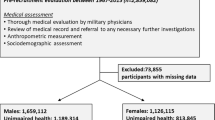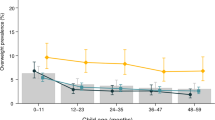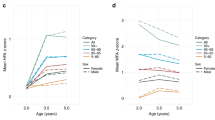Abstract
Objective:
To elaborate Mexican growth charts based on international methodology.
Design:
Data were obtained from the Mexican National Health Survey. The survey was stratified and probabilistic representative of all the country.
Setting:
Nationwide open population living in urban and rural areas.
Subjects:
Boys (8545) and girls (9983) from 10 to 18 years participating in the survey.
Methods:
Age, weight and height were recorded. Empirical percentiles were calculated and smoothed. Smoothed curves were approximated using least-mean square estimation.
Results:
Tables and figures for percentile values of weight, height and body mass index (BMI) for age, as well as percentile values of weight and BMI for height for both genders are presented. Regarding 50th BMI for age percentiles, Mexicans had higher levels than the Americans in the Centers for Disease Control and Prevention growth charts; Mexicans were lower but had similar weights than the Americans. Owing to the high BMI, the percentile corresponding to an overweight level (25 kg/m2) at 18 years was 74.5 in boys and 72.5 in girls, whereas obesity level (30 kg/m2) at 18 years was 97.3 and 97.4 in boys and girls, respectively.
Conclusions:
The present growth charts are snapshots of a Mexican population. Because the high median BMI compared to US and World Health Organization standards, we must be cautious in establishing an upper normal cutoff for clinical normality, not merely selecting the 85th and 95th percentiles as equivalents of overweight and obesity, respectively. Therefore, we proposed percentiles 74.5 in boys and 72.5 in girls as the action points of overweight as they are the percentiles corresponding to BMI 25 kg/m2 at 18 years.
Sponsorship:
The survey was supported by the Mexican Minister of Health. Statistical analyses were sponsored by Dr Del-Rio-Navarro.
This is a preview of subscription content, access via your institution
Access options
Subscribe to this journal
Receive 12 print issues and online access
$259.00 per year
only $21.58 per issue
Buy this article
- Purchase on Springer Link
- Instant access to full article PDF
Prices may be subject to local taxes which are calculated during checkout





Similar content being viewed by others
References
Abrantes MM, Lamounier JA, Colosimo EA (2003). Comparison of body mass index values proposed by Cole et al. (2000) and Must et al. (1991) for identifying obese children with weight-for-height index recommended by the World Health Organization. Public Health Nutr 6, 307–311.
Anderson SE, Dallal GE, Must A (2003). Relative weight and race influence average age at menarche: results from two nationally representative surveys of US girls studied 25 years apart. Pediatrics 111 (Part 1), 844–850.
Burrows R (2001). Evaluación del Estado Nutricional del Escolar y Adolescente. Nutrición del escolar y adolescente. Sociedad Chilena de Pediatría: Santiago de Chile.
Burrows R, Muzzo S (1999). Estándares de crecimiento y desarrollo del escolar chileno. Rev Chil Nutr 26 (Suppl 1), 95–162.
Cole TJ, Bellizzi MC, Flegal KM, Dietz WH (2000). Establishing a standard definition for child overweight and obesity worldwide: international survey. BMJ 320, 1240–1243.
de Onis M, Habicht JP (1996). Anthropometric reference data for international use: recommendations from a World Health Organization Expert Committee. Am J Clin Nutr 64, 650–658.
Del-Rio-Navarro BE, Velázquez-Monroy O, Sánchez-Castillo CP, Lara-Esqueda A, Berber A, Fanghänel G et al. (2004). The high prevalence of overweight and obesity in Mexican children. Obes Res 12, 215–223.
Deurenberg P, Yap M, van Staveren WA (1998). Body mass index and percent body fat: a meta analysis among different ethnic groups. Int J Obes Relat Metab Disord 22, 1164–1171.
Dibley MJ, Goldsby JB, Staehling NW, Trowbridge FL (1987a). Development of normalized curves for the international growth reference: historical and technical considerations. Am J Clin Nut 46, 736–748.
Dibley MJ, Staehling N, Nieburg P, Trowbridge FL (1987b). Interpretation of Z-score anthropometric indicators derived from the international growth reference. Am J Clin Nutr 46, 749–762.
Dietz WH, Bellizzi MC (1999). Introduction: the use of body mass index to assess obesity in children. Am J Clin Nutr 70 (Suppl), 123S–125S.
Flegal KM (1999). Curve smoothing and transformations in the development of growth curves. Am J Clin Nutr 70, 163S–165S.
Franklin M (1999). Comparison of weight and height relations in boys from 4 countries. Am J Clin Nutr 70 (Part 2), 157S–162S.
Gómez-Díaz RA, Martinez-Hernandez AJ, Aguilar-Salinas CA, Violante R, Alarcon ML, Villarruel MJ et al. (2005). Percentile distribution of the waist circumference among Mexican pre-adolescents of a primary school in Mexico City. Diabetes Obes Metab 7, 16–21.
Graitcer PL, Gentry EM (1981). Measuring children: one reference for all. Lancet 2, 297–299.
Hamill PV, Drizd TA, Johnson CL, Reed RB, Roche AF, Moore WM (1979). Physical growth: National Center for Health Statistics percentiles. Am J Clin Nutr 32, 607–629.
He Q, Karlberg J (2001). BMI in childhood and its association with height gain, timing of puberty, and final height. Pediatr Res 49, 244–251.
Hernández B, Cuevas-Nasu L, Shamah-Levy T, Monterrubio EA, Ramirez-Silva CI, Garcia-Feregrino R et al. (2003). Factors associated with overweight and obesity in Mexican school-age children: results from the National Nutrition Survey 1999. Salud Publica Mex 45 (Suppl 4), S551–S557.
Hernández B, Gortmaker SL, Colditz GA, Peterson KE, Laird NM, Parra-Cabrera S et al. (1999). Association of obesity with physical activity, television programs and other forms of video viewing among children in Mexico City. Int J Obes Relat Metab Disord 23, 845–854.
Hernandez-Diaz S, Peterson KE, Dixit S, Hernández B, Parra S, Barquera S et al. (1999). Association of maternal short stature with stunting in Mexican children: common genes vs common environment. Eur J Clin Nutr 53, 938–945.
Hurtado-Valenzuela JG, Sotelo-Cruz N (2005). Increase of obesity in school children who attend ambulatory services of the Pediatric Hospital of the Sonora State. Salud Publica Mex 47, 257–258.
Kain J, Uauy R, Lera L, Taibo M, Espejo F, Albala C (2005). Evolution of the nutritional status of six years old Chilean children (1987–2003). Rev Med Chil 133, 1013–1020.
Kain J, Uauy R, Vio F, Albala C (2002). Trends in overweight and obesity prevalence in Chilean children: comparison of three definitions. Eur J Clin Nutr 56, 200–204.
Kuczmarski RJ, Ogden CL, Guo SS, Grummer-Strawn LM, Flegal KM, Mei Z et al. (2002). 2000 CDC growth charts for the United States: methods and development. Vital Health Stat 246, 1–190.
Menchaca Martin P, Zonana Nacach A (2006). Obesity in Mexican children from the Northern border. Salud Publica Mex 48, 1.
Ogden CL, Carroll MD, Curtin LR, McDowell MA, Tabak CJ, Flegal KM (2006). Prevalence of overweight and obesity in the United States, 1999–2004. JAMA 295, 1549–1555.
Ogden CL, Kuczmarski RJ, Flegal KM, Mei Z, Guo S, Wei R et al. (2002). Centers for Disease Control and Prevention 2000 growth charts for the United States: improvements to the 1977 National Center for Health Statistics version. Pediatrics 109, 45–60.
Olaiz-Fernández G, Rivera-Dommarco J, Shamah-Levy T, Rojas R, Villalpando-Hernández S, Hernández-Avila M et al. (2006). Encuesta Nacional de Salud y Nutrición 2006. Instituto Nacional de Salud Pública: Cuernavaca, México.
Ramos-Galvan R (1975). Pediatric somatometry. Semilongitudinal study of children in Mexico City. Arch Invest Med (Mexico) 6 (Suppl 1), 83–396.
Reilly JJ, Dorosty AR, Emmett PM (2000). The ALSPAC Study Team: Identification of the obese child: adequacy of the body mass index for clinical practice and epidemiology. Int J Obes Relat Metab Disord 24, 1623–1627.
Rivera JA, Barquera S, Campirano F, Campos I, Safdie M, Tovar V (2002). Epidemiological and nutritional transition in Mexico: rapid increase of non-communicable chronic diseases and obesity. Public Health Nutr 5, 113–122.
Rivera-Dommarco J, Shamah-Levy T, Villalpando-Hernández S, González de Cossío T, Hernández-Prado B, Sepúlveda J (2001). Encuesta Nacional de Nutrición 1999. Estado nutricio de niños y mujeres en México. Instituto Nacional de Salud Pública: Cuernavaca, Morelos, México.
Sánchez-Castillo CP, Lara JJ, Villa AR, Aguirre J, Escobar M, Gutierrez H et al. (2001). Unusually high prevalence rates of obesity in four Mexican rural communities. Eur J Clin Nutr 55, 833–840.
Stein AD, Thompson AM, Waters A (2005). Childhood growth and chronic disease: evidence from countries undergoing the nutrition transition. Matern Child Nutr 1, 177–184.
Uauy R, Albala C, Kain J (2001). Obesity trends in Latin America: transiting from under- to overweight. J Nutr 131, 893S–899S.
Valdespino JL, Olaiz G, López-Barajas MP, Mendoza L, Palma O, Velázquez O et al. (2003). Encuesta Nacional de Salud 2000. Tomo I. Vivienda, población y utilización de servicios de salud. Instituto Nacional de Salud Pública: Cuernavaca, Morelos, México.
Villa-Caballero L, Caballero-Solano V, Chavarria-Gamboa M, Linares-Lomeli P, Torres-Valencia E, Medina-Santillan R et al. (2006). Obesity and socioeconomic status in children of Tijuana. Am J Prev Med 30, 197–203.
Violante R, del Rio Navarro BE, Berber A, Ramirez Chanona N, Baeza Bacab M, Sienra Monge JJ (2005). Obesity risk factors in the ISAAC (International Study of Asthma and Allergies in Childhood) in Mexico City. Rev Alerg Mex 52, 141–145.
Wang Y, Monteiro C, Popkin BM (2002). Trends of obesity and underweight in older children and adolescents in the United States, Brazil, China, and Russia. Am J Clin Nutr 75, 971–977.
World Health Organization (1978). A Growth Chart for International Use in Maternal and Child Health Care: Guidelines for Primary Health Care Personnel. World Health Organization: Geneva, Switzerland.
Yamamoto-Kimura L, Posadas-Romero C, Posadas-Sanchez R, Zamora-Gonzalez J, Cardoso-Saldana G, Mendez Ramirez I (2006). Prevalence and interrelations of cardiovascular risk factors in urban and rural Mexican adolescents. J Adolesc Health 38, 591–598.
Author information
Authors and Affiliations
Corresponding author
Rights and permissions
About this article
Cite this article
Del-Rio-Navarro, B., Velazquez-Monroy, O., Santos-Preciado, J. et al. Mexican anthropometric percentiles for ages 10–18. Eur J Clin Nutr 61, 963–975 (2007). https://doi.org/10.1038/sj.ejcn.1602612
Received:
Revised:
Accepted:
Published:
Issue Date:
DOI: https://doi.org/10.1038/sj.ejcn.1602612
Keywords
This article is cited by
-
Perceived body shape, standardized body-mass index, and weight-specific quality of life of African-American, Caucasian, and Mexican-American adolescents
Quality of Life Research (2012)
-
Body mass index percentiles for children and adolescents in Germany based on a nationally representative sample (KiGGS 2003–2006)
European Journal of Clinical Nutrition (2010)
-
Mexican anthropometry percentiles and the LMS method
European Journal of Clinical Nutrition (2009)



